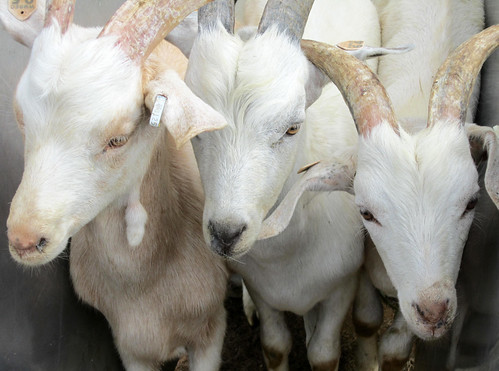During the first four years of the test (2006-09), rainfall for June, July, and August ranged from 10.02 to 14.34 inches. It averaged 12.05 inches. This year's total rainfall for June, July, and August is just 4.01 inches. Combined with the record high temperatures experienced at the research center, this has been a very challenging year for the goats on test.
 |
| Click on image to view a larger version in a new window |
It goes without saying that the hot, dry weather has resulted in poor quality forage conditions throughout most of the testing period and that this has not allowed the goats to express their genetic potential for maximum growth. On the other hand, goats are not likely to be profitable if they are pushed for maximum gain. In fact, goats are the livestock probably best-adapted to the type of weather we have experienced this year.
Hardy bucks
Any goat (or livestock) can do well when the feed supply is plentiful and they are regularly dewormed. The heat and drought have been major "stressors" in this year's test and most of the goats have risen to the challenge. Most have proven themselves to be quite hardy and adaptable. This is the year, I'd want to buy a buck.
While we wish the goats would supplement their poor forage diet with the protein tubs and grass hay that is available to them, it is quite impressive how they are managing on the all-but-depleted pastures. They have never gotten anything from the two acres of chicory. It was mowed prior to the start of the test and did not receive enough moisture to recover. Thus, the 67-72 goats have been maintained on just 8 acres of pasture since June 5.
The two-acre paddock of pearl millet has been grazed down, but some forage re-growth is occurring. The goats were given a fresh bale of hay, as the first bale got moldy. There are a few acres of woodland pasture behind the test area that we may be able to put the goats in for some extra nutrition.
 |
| Three Kiko bucks standing in the chute. |
Scanning
Next week, the goats will be scanned to determine back fat and rib eye area. Jim Pritchard from West Virginia State University will do the scanning. In addition to collecting the usual data, the goats will be evaluated for reproductive and structural soundness. We will measure scrotal size and splits. We will count and characterize teat structure. We will measure overbites/underbites. The goats will be visually appraised for structural correctness. A goat will only be disqualified from the sale if it is determined to have a "functional" problem.
Sale bucks
After the data collection on September 9, we should have a good idea as to which goats will likely be in the sale. The selection standards for the sale will differ from last year, especially for growth, as this year's environmental conditions have resulted in different levels of performance and parasite challenge. Final selections for the sale will be made after data collection on September 23. Pictures and data of the sale bucks will be posted to the web. Per requests, pictures can be taken for private treaty sales.
Doe consignments
Nominations for the doe sale are requested by September 10. Having does in the sale broadens the appeal of the buck sale, especially if doe consignments include does of different ages (kids and yearlings) and different breeds and crosses. Consignors may nominate three does for each buck they have in the test. There is a consignment form for does on this blog. The form can be filled out online for printing, scanning, or faxing.
Doe consignment form











